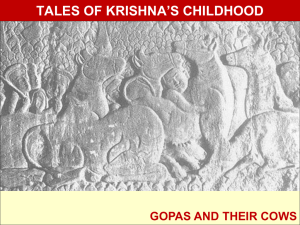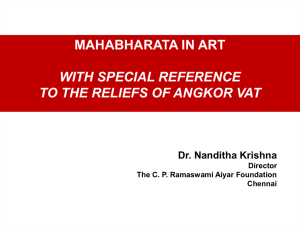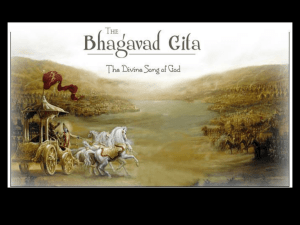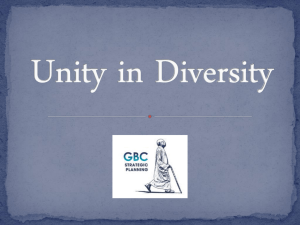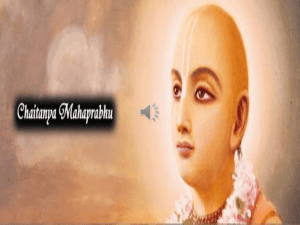LordKrishna - Michael Sudduth
advertisement
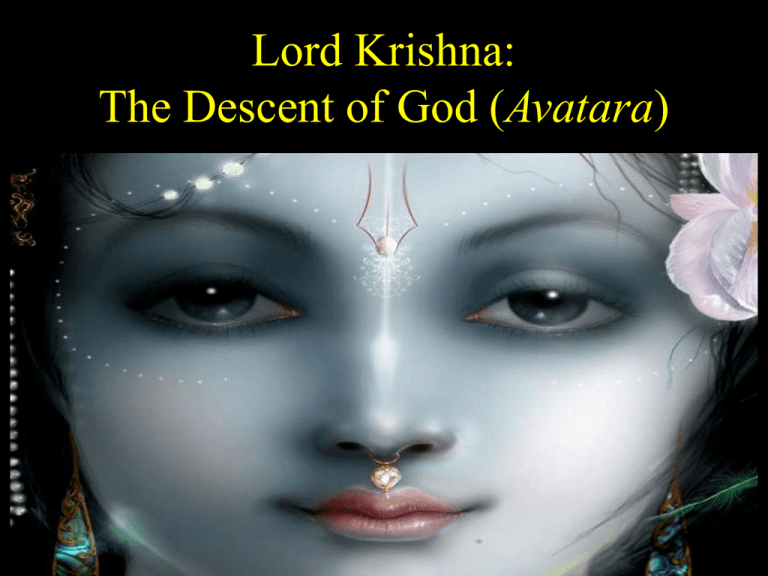
Lord Krishna: The Descent of God (Avatara) Krishna, of the Vrishni family (cousin to the Pandavas and Kauravas) had already established himself as a powerful warrior and prince in Mathura, where he had re-established righteousness after destroying the evil ruler King Kamsa and establishing a kingdom in Dwaraka. ★ ★ Krishna befriended Arjuna in Mathura. He had been watching the evolving conflict between the Pandavas and Kauravas. He eventually intervenes to arbitrate the conflict and becomes the focal point of the war. Krishna is revealed to be God manifested on earth, delivering a message of universal salvation. Krishna is one of the most important and widely worshipped deities in the Indian religious traditions. Although the modern worship of Krishna has been strongly shaped by the evolution of devotional theism from the 9th century CE onwards, • ancient texts from Greece provide evidence of the worship of Krishna as a divine being in the 5th/4th century BCE. • archeological evidence for the worship of Krishna dates at least to the end of the 2nd century BCE. In the fabric of contemporary Indian devotional religion (tracing back to at least the 9th century CE), Vaishnavas worship Krishna as an avatar of Vishnu, “Vishnu” (meaning “all pervasive”), one of the names that refers to the Supreme Being. Gaudiya Vaishnavism (early 16th century), along with the sampradayas associated with Vallabha and Nimbarka, regard Krishna as svayam bhagavan (the original form of God) and Vishnu is merely an expansion from the being of Krishna. Textual Sources on the Life of Krishna • Bhagavad Gita (Mahabharata text, circa 400-200 BCE) • Srimad Bhagavatam (Purana literature, 4th-6th century CE) • Harivamsa (lengthy appendix to Mahabharata, 5th century CE) • Vishnu Purana (Purana literature, 5th century CE) * The dates above are assigned for the composition of the texts. The material in the text is generally believed to originate from a significantly earlier period. I. Krishna’s Birth Aware that unrighteousness had spread throughout Bharatavarsha (India) under the influence of evil rulers, Vishnu (the Supreme Being and source of all universes) decided to incarnate himself on earth to destroy evil rulers and restore righteousness on earth. I. Krishna’s Birth So Vishnu incarnated himself in the city of Mathura, which was under the control of the evil ruler King Kamsa. Vishnu decided to take human form as the 8th son of Devaki, the sister of King Kamsa. His name was Krishna – “the all-attractive one.” After being born in Mathura, Krishna was quickly taken to the nearby pastoral town of Vrindavana to escape the murderous plotting of King Kamsa. There he was raised by foster parents Nanda and Yashoda. II. Young Krishna of Vrindavan (Vraj) The Krishna of Vrindavana is a flute playing cow herder who attracts the men (gopas) and women (gopis) of the pastoral town by his playful activities and beauty. Krishna would play the flute and dance with the multitude of gopis along the Yamuna river. They fell madly in love with Krishna. As a youth in Vraj, Krishna sometimes engaged in highjinx, for example, stealing the clothes of the gopis while they bathed naked. The gopis had previously asked the goddess Durga to have Krishna as their husband. Since only husbands were permitted to view a woman naked, Krishna’s high-jinx was a way of his proclaiming that he loved the gopis with conjugal love and accepted them as his own wives. The gopis’ love for Krishna was so great that they cursed brahma (the creator) for creating them with eyes that blinked. Every time they blinked, it was a second in time that they could not look upon the beauty of Krishna. “Their hearts had been stolen by Govinda, so they did not return back when husbands, fathers, brothers, and relatives tried to prevent them. They were in a state of rapture. Some gopis, not being able to find a way to leave, remained at home and thought of Krishna with eyes closed, completely absorbed in meditation.” Srimad Bhagavata, 10.29.9-10 When they were prevented from seeing Krishna because of their household duties, Krishna said: “Love for me comes from hearing about me, seeing me, meditating on me and reciting my glories, not in this way, by physical proximity. Therefore, return to your homes.” Srimad Bhagavata, 10.29.27 Among the gopis, one stood supreme, the particular object of Krishna’s most intense love and devotion – Radha. Radha is depicted as the model devotee, one whose love for Krishna was unrivaled. She thought of Krishna constantly, even in her dreams. Her love was so powerful that it controlled and subjugated Krishna himself. He lost himself so completely in her love that he even forgot that he was God. To signify the depth of their union, they are often spoken of as one God: Radha-Krishna. As an adolescent, Krishna had to leave Vraj for Mathura to destroy the evil King Kamsa. Radha and Krishna part with deep sadness. After Krishna’s departure from Vraj, the gopis search for him with intensity, inquiring of the plants and trees if they have seen Krishna. Their love, like Radha’s, was intensified through separation. The Moods of Vrindavan Krishna • Vrindavan Krishna cultivates diverse moods (rasa) of closeness and intimacy through his many attractive features and activities (rasa lilas), for example: – Friendship: a person relates to Krishna as to a close friend. – Romantic Love: a person relates to Krishna as to a lover. • Krishna’s madhurya qualities form the basis of such moods of intimacy. “Madhurya” means “sweet.” Krishna’s madhurya qualities are his human qualities that attract devotees to a close relationship with him. These qualities are III. Lord Krishna of Mathura and Dwaraka While Vraj Krishna is the playful youth who cultivates moods of intimacy with his devotees, the Krishna of Mathura and Dwaraka cultivates the mood of awe and reverence through the overt display of divine qualities (e.g., omnipotence, omniscience). Krishna’s Godhead was only implicit in Vraj. The Vraj devotees were so attracted to Krishna’s human qualities that they suppressed their knowledge of his Godhead. They regarded his supernatural powers displayed in Vraj as bestowed on him by Narayana (God Vishnu). The Godhead of Krishna is emphasized at the battle at Kurukshetra in the Bhagavad Gita text (Mahabharata War) The Krishna of the Gita is overtly God manifested in human form on earth to reinstate moral order and provide spiritual guidance to humanity. As avatara (“the descent” of God in human form) Krishna manifests madhurya and aishvarya qualities. • Madhurya (sweetness): human qualities that attract and cultivate modes of intimacy • Aishvarya (opulence): divine qualities that instill awe and reverence. Love of Krishna may take various forms: love of intimacy, love of reverence, and love that unites both. Krishna’s Role in the Mahabharata War • Krishna intervenes in the Pandava-Kaurava conflict. • Krishna refused to fight in the war, but he offered himself as charioteer (for one side) and his invincible army (for the other side). • The Kauravas chose to accept Krishna’s army. • The Pandavas chose Krishna himself, even though his role would be confined to guiding the chariot of his cousin and friend Arjuna. Arjuna and Krishna: the Battle at Kurukshretra References • Bryant, Edwin (trans). Krishna: the Beautiful Legend of God, Srimad Bhagavata Purana, Book X. Penguin Books, 2003. • Menon, Ramesh (trans). The Mahabharata : a modern rendering. New York: iUniverse, Inc., 2006. • Prabhupada, A.C. Bhaktivedanta Swami. Krishna: The Supreme Personality of the Godhead. Bhaktivedanta Book Trust, 1970. • Rosen, Steven (ed). Holy War: Violence and the Bhagavad Gita. Deepak Heritage Books, 2002. • Rosen, Steven. The Hidden Glory of India. Bhaktivendanta Book Trust, 2002. • Singer, Milton (ed). Krishna: Myths, Rites, and Attitudes. University of Chicago Press, 1966. • Tripurari, Swami B.V.. Aesthetic Vedanta. Mandala, 1998. • Vanamali, Devi. The Play of God: Visions of the Life of Krishna. Blue Dove Press, 1998.

